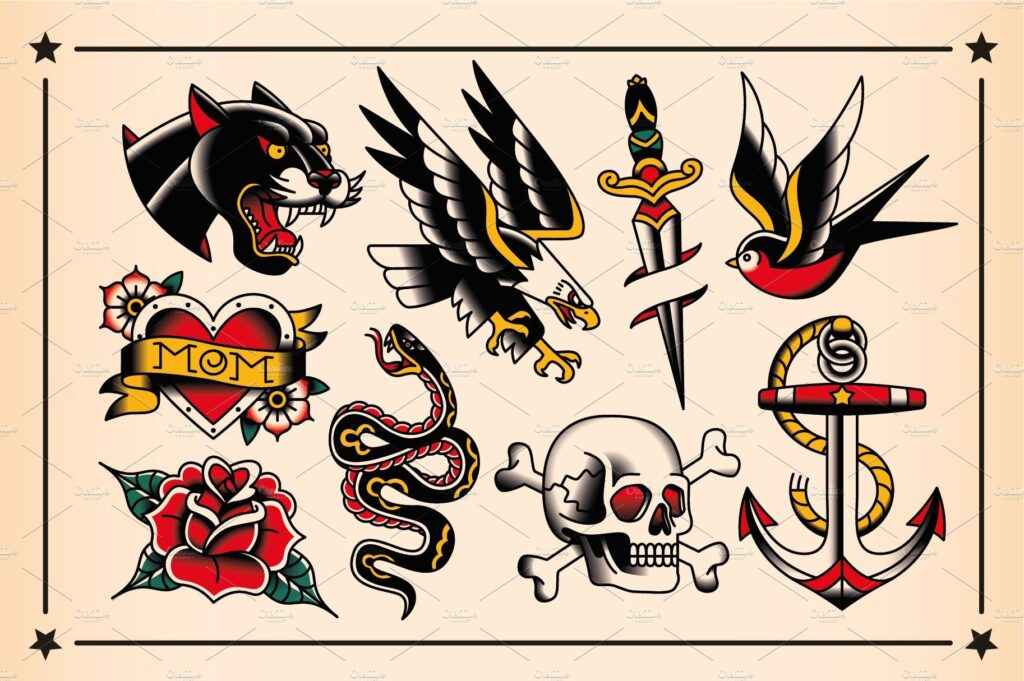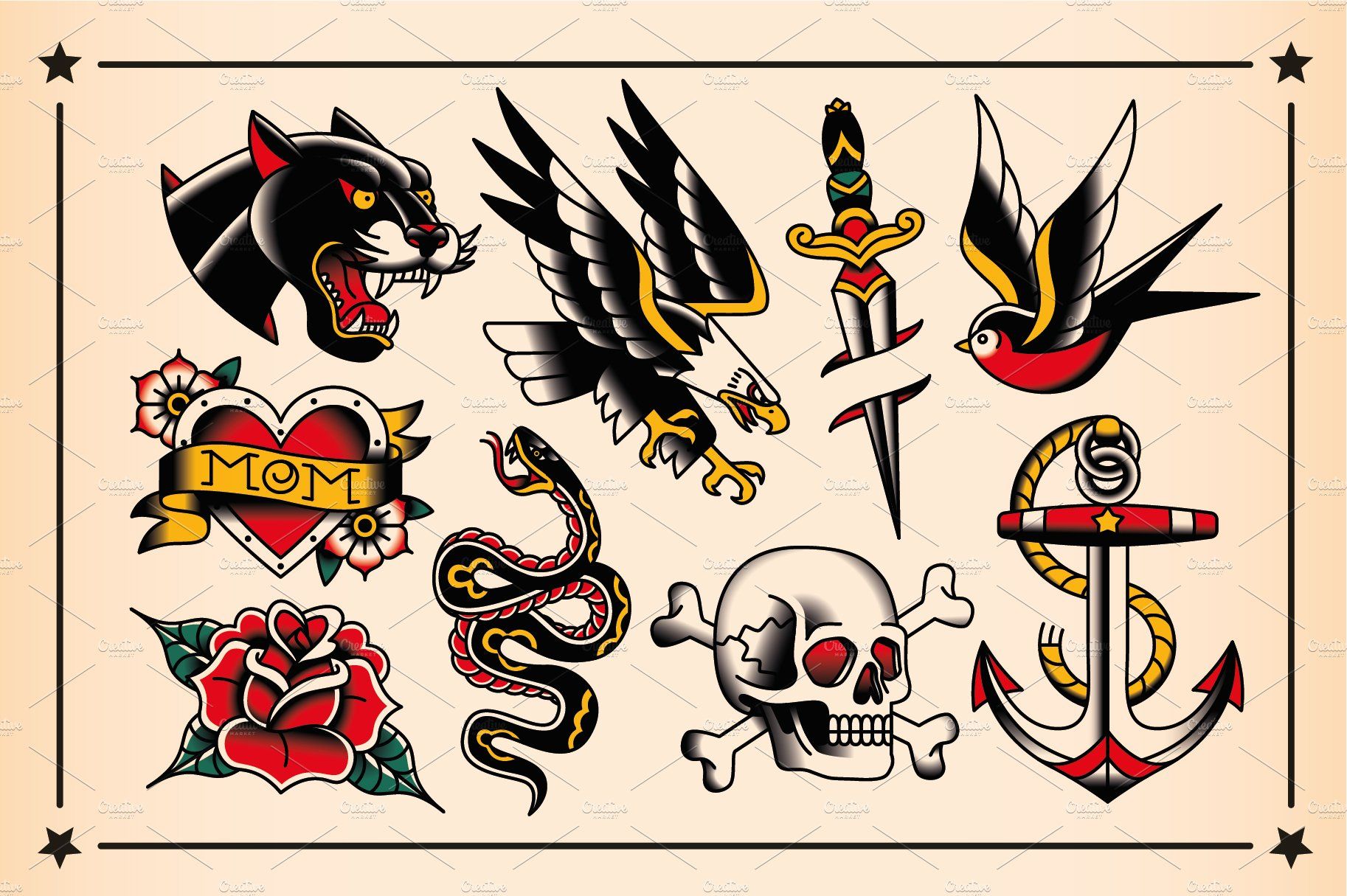
Decoding Traditional Mens Tattoos: History, Meaning, and Modern Interpretations
Traditional mens tattoos are more than just ink; they are powerful symbols steeped in history, culture, and personal narratives. From the bold lines of American traditional tattoos to the intricate patterns of Polynesian designs, these tattoos represent a rich tapestry of human experience. This article delves into the origins, meanings, and enduring appeal of traditional mens tattoos, exploring how they continue to resonate in the modern world.
The Roots of Traditional Mens Tattoos
The history of traditional mens tattoos stretches back millennia, with evidence of tattooing found in cultures across the globe. For many societies, tattoos were not merely decorative; they served as markers of status, indicators of tribal affiliation, and symbols of courage or accomplishment. Understanding these historical roots is crucial to appreciating the depth and significance of traditional mens tattoos.
Ancient Origins and Cultural Significance
Tattooing has been practiced for thousands of years. Ötzi the Iceman, who lived over 5,000 years ago, was discovered with tattoos, suggesting that this practice dates back to at least the Copper Age. In ancient cultures like Egypt and Polynesia, tattoos held deep spiritual and social significance. Egyptian mummies have been found with tattoos, indicating that they were used for both medicinal and religious purposes. Polynesian cultures, in particular, developed elaborate tattooing traditions known as *tatau*, which played a crucial role in expressing identity, lineage, and social standing. For men, these tattoos often signified their transition into adulthood and their role within the community.
The Influence of Maritime Culture
Maritime culture played a significant role in the development and spread of traditional mens tattoos, particularly in the West. Sailors, who traveled the world and encountered diverse cultures, adopted and adapted tattooing practices from the regions they visited. These early maritime tattoos often featured nautical themes such as anchors, ships, and swallows, which carried symbolic meanings related to seafaring life. For instance, an anchor symbolized stability and hope, while swallows represented the idea of returning home safely after a long voyage. These symbols became iconic representations of traditional mens tattoos and continue to be popular today. The exchange of tattooing techniques and motifs between sailors from different nations contributed to the evolving landscape of traditional mens tattoos.
Key Styles and Motifs in Traditional Mens Tattoos
Traditional mens tattoos encompass a wide range of styles and motifs, each with its own distinct characteristics and symbolism. From the bold simplicity of American traditional tattoos to the intricate detailing of Japanese designs, these styles reflect the diverse cultural influences that have shaped the art of tattooing.
American Traditional Tattoos: Bold and Timeless
American traditional tattoos, also known as old school tattoos, are characterized by their bold outlines, vibrant colors, and classic imagery. This style emerged in the early 20th century, largely influenced by the maritime culture and the work of pioneering tattoo artists like Norman “Sailor Jerry” Collins. Common motifs in American traditional tattoos include anchors, roses, eagles, hearts, and pin-up girls. These images are often imbued with symbolic meanings, such as love, loyalty, and patriotism. The enduring appeal of American traditional tattoos lies in their simplicity, clarity, and timeless aesthetic. The thick lines and limited color palette ensure that these tattoos age well, maintaining their visual impact over time. They continue to be a popular choice for men seeking a classic and meaningful tattoo.
Japanese Traditional Tattoos: Art and Symbolism
Japanese traditional tattoos, or *irezumi*, are renowned for their intricate designs, rich symbolism, and meticulous execution. This style dates back centuries and is deeply rooted in Japanese history and mythology. Common motifs in Japanese traditional tattoos include dragons, koi fish, tigers, and cherry blossoms, each carrying its own symbolic weight. Dragons, for example, represent wisdom, strength, and protection, while koi fish symbolize perseverance and good fortune. The process of getting a Japanese traditional tattoo is often a lengthy and involved one, requiring multiple sessions and a deep commitment from the wearer. These tattoos are not merely decorative; they are considered a form of self-expression and a reflection of one’s character and values. The artistry and symbolism of Japanese traditional tattoos make them a highly respected and sought-after style of traditional mens tattoos. [See also: Japanese Tattoo History and Meaning]
Polynesian Tattoos: Identity and Ancestry
Polynesian tattoos, also known as *tatau*, are characterized by their intricate patterns and geometric designs, which are used to convey information about a person’s identity, lineage, and social status. These tattoos are deeply rooted in Polynesian culture and are considered a sacred practice. Each symbol and pattern in a Polynesian tattoo carries a specific meaning, and the placement of the tattoo on the body is also significant. For men, Polynesian tattoos often cover large portions of the body, such as the arms, legs, and chest, and are seen as a symbol of strength, courage, and manhood. The process of getting a Polynesian tattoo is often a painful and transformative experience, marking a person’s passage into adulthood and their connection to their ancestors. The artistry and cultural significance of Polynesian tattoos make them a powerful and meaningful form of traditional mens tattoos.
The Enduring Appeal of Traditional Mens Tattoos
Despite the ever-evolving landscape of tattoo art, traditional mens tattoos continue to hold a special place in the hearts of many. Their enduring appeal lies in their timeless aesthetic, rich symbolism, and connection to history and culture. These tattoos are not merely a fashion statement; they are a form of self-expression and a way to connect with the past.
Timeless Aesthetics and Classic Imagery
One of the key reasons for the enduring appeal of traditional mens tattoos is their timeless aesthetic. The bold lines, vibrant colors, and classic imagery of styles like American traditional tattoos ensure that these designs remain visually striking and relevant over time. Unlike some contemporary tattoo styles that may fade in popularity, traditional tattoos have a lasting quality that transcends trends. The simplicity and clarity of these designs also contribute to their longevity, making them easy to recognize and appreciate. Whether it’s an anchor symbolizing stability or a rose representing love, the classic imagery of traditional mens tattoos continues to resonate with people of all ages and backgrounds. This enduring aesthetic is a testament to the skill and artistry of the tattoo artists who have preserved and evolved these styles over the years.
Connection to History and Culture
Traditional mens tattoos offer a tangible connection to history and culture, providing a way to honor the traditions and values of past generations. Styles like Japanese traditional tattoos and Polynesian tattoos are deeply rooted in their respective cultures, carrying with them centuries of history and symbolism. By getting a traditional tattoo, men can express their appreciation for these cultures and connect with the stories and meanings that have been passed down through generations. Even American traditional tattoos, with their maritime and military influences, offer a glimpse into the history of the United States and the experiences of those who have shaped the nation. This connection to history and culture adds depth and meaning to traditional mens tattoos, making them more than just decorative body art. They become a form of cultural expression and a way to honor the past. [See also: The History of Sailor Jerry]
Personal Expression and Meaning
Ultimately, traditional mens tattoos are a form of personal expression, allowing men to showcase their individuality, beliefs, and experiences. The symbolism embedded in traditional tattoo motifs provides a rich vocabulary for self-expression, enabling men to communicate their values, aspirations, and personal stories through their body art. Whether it’s a dragon representing strength and wisdom or a heart symbolizing love and compassion, traditional tattoos offer a powerful way to convey personal meaning. The act of getting a tattoo can also be a transformative experience, marking a significant event or milestone in a person’s life. The pain and commitment involved in the process can create a deep connection to the tattoo, making it a cherished and meaningful symbol of personal growth and identity. The ability to express oneself through traditional mens tattoos is a key reason for their enduring popularity and relevance.
Modern Interpretations and Trends
While traditional mens tattoos are rooted in history and culture, they continue to evolve and adapt to modern trends and interpretations. Contemporary tattoo artists are finding new ways to incorporate traditional motifs and styles into their work, creating innovative and unique designs that appeal to a new generation of tattoo enthusiasts.
Neo-Traditional Tattoos: A Modern Twist
Neo-traditional tattoos represent a modern take on classic tattoo styles, blending traditional motifs with contemporary techniques and aesthetics. This style is characterized by its bold lines, vibrant colors, and intricate detailing, often incorporating elements of realism and illustrative art. Neo-traditional tattoos allow artists to push the boundaries of traditional tattoo art while still honoring its roots. Common motifs in neo-traditional tattoos include animals, flowers, and portraits, often rendered with a high level of detail and shading. This style appeals to those who appreciate the classic aesthetic of traditional tattoos but are looking for a more modern and personalized design. The versatility and artistry of neo-traditional tattoos make them a popular choice for men seeking a unique and expressive form of body art.
Incorporating Traditional Motifs into Contemporary Designs
Many contemporary tattoo artists are incorporating traditional motifs into their designs, creating a fusion of old and new styles. This approach allows for endless possibilities, as artists can combine traditional imagery with modern techniques and concepts to create truly unique and personalized tattoos. For example, an artist might incorporate a traditional Japanese dragon into a geometric design or combine American traditional motifs with minimalist aesthetics. This fusion of styles allows for greater creativity and self-expression, appealing to those who appreciate the history and symbolism of traditional tattoos but are looking for something fresh and innovative. The ability to blend traditional and contemporary elements is a testament to the enduring appeal and adaptability of traditional mens tattoos.
The Revival of Traditional Tattooing Techniques
In recent years, there has been a growing interest in traditional tattooing techniques, such as hand-poked tattoos and traditional Japanese *tebori*. These techniques involve using hand-held tools rather than electric tattoo machines to apply the ink, resulting in a unique and distinctive look. Hand-poked tattoos, in particular, have gained popularity for their simplicity and authenticity, offering a more intimate and personal tattooing experience. Traditional Japanese *tebori* is a highly skilled and time-consuming technique that requires years of training and practice. The revival of these traditional techniques reflects a desire to connect with the history and artistry of tattooing, offering a more authentic and meaningful experience for both the artist and the wearer. This renewed interest in traditional tattooing techniques is a testament to the enduring legacy of traditional mens tattoos. [See also: Hand Poked Tattoo Guide]
Conclusion: The Enduring Legacy of Traditional Mens Tattoos
Traditional mens tattoos are more than just ink on skin; they are a powerful form of self-expression, a connection to history and culture, and a testament to the enduring human desire to adorn and decorate the body. From the ancient origins of tattooing to the modern interpretations of traditional styles, these tattoos continue to resonate with men around the world. Whether it’s the bold simplicity of American traditional tattoos, the intricate symbolism of Japanese designs, or the cultural significance of Polynesian patterns, traditional mens tattoos offer a rich and diverse tapestry of human experience. As tattoo art continues to evolve, the legacy of traditional mens tattoos will undoubtedly endure, inspiring new generations of artists and enthusiasts to explore the depths of this ancient and meaningful art form. The enduring popularity of traditional mens tattoos is a testament to their timeless appeal and their ability to connect us to the past while expressing our individuality in the present.

